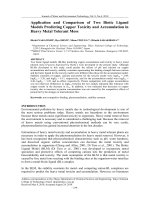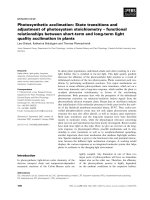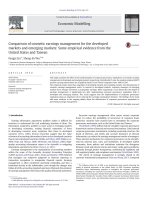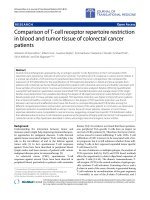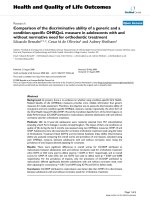Comparison of lumbopelvic hip muscle activity between individuals with and without patellofemoral pain
Bạn đang xem bản rút gọn của tài liệu. Xem và tải ngay bản đầy đủ của tài liệu tại đây (254.87 KB, 2 trang )
Comparison of Lumbopelvic
Hip Muscle Activity Between
Individuals With and Without
Patellofemoral Pain
Katbamna RY, Mangum LC, Hart
JM, Saliba SA: University of
Virginia, Charlottesville, VA
Context: Patellofemoral pain (PFP)
is one of the most common knee conditions in the physically active population. Its etiology remains unknown;
however, there may be a contribution
from proximal musculature in the
lumbopelvic hip complex, including:
transverse abdominis (TrA), gluteus
maximus (GMax), and gluteus medius
(GMed). Although strength and muscle
activation are often assessed, ultrasound
imaging can also be used to evaluate
the function of these muscles between
healthy and PFP patients. Objective:
To compare muscle thickness changes
of the TrA, GMax, and GMed using ultrasound imaging between participants
with and without patellofemoral pain in
multiple unloaded and loaded positions.
Design: Descriptive laboratory study.
Setting: Laboratory. Patients or Other
Participants: 24 total participants (12
PFP: Age = 24.0 ± 5.5 years, Height
= 167.2 ± 7.6 cm, Mass = 71.9 ± 18.9
kg; 12 healthy: Age = 20.3 ± 1.7 years,
Height = 174.8 ± 11.6 cm, Mass = 72.5
± 14.4 kg) volunteered for the study.
Interventions: Ultrasound imaging
with a wireless linear transducer was
used to visualize muscle thickness of the
abdominal wall muscles (TrA) and gluteals (GMax, GMed). Main Outcome
Measures: Static ultrasound images
were captured in resting and contracted
states with participants placed in multiple positions (tabletop, bipedal standing, single leg stance, and single leg
squat). The abdominal draw-in maneuver was used as the contraction for TrA
in tabletop and standing, while side-lying hip abduction was used for gluteal
contraction in tabletop and a gluteal
squeeze as contraction during standing. Muscle thickness during the single leg stance and single leg squat was
normalized to a bipedal quiet standing
Journal of Athletic Training
thickness to identify percent activation
beyond quiet standing. 95% confidence
intervals (CI) were also calculated for
each mean difference. Cohen’s d effect
sizes were used to represent the magnitude of difference between groups.
Results: Compared to the healthy individuals, the participants with PFP had a
27% (0.27; CI: 0.25, 0.30) increase in
activation of the TrA during standing (P
= .04, d = .87 [CI: 0.03, 1.71]) and a
10% (0.10; CI: 0.07, 0.12) decrease in
GMax activation (P = .008, d = -1.37
[CI: -2.26, -0.48]) in the same position.
During the single leg squat, healthy
participants had a 21% (0.21; CI: 0.17,
0.24) increase in GMed activity (P
= .003, d = -1.47 [CI: -2.37, -0.57]).
There were no other significant differences between groups found in any of
the muscles or positions. Conclusions:
Individuals with PFP had a large difference in lumbopelvic hip muscle activation compared to the healthy controls
while standing and performing a single
leg squat, as measured via ultrasound
imaging. The increase in TrA activity
found in those with PFP may indicate
a protective mechanism while standing
in a loaded position due to dysfunction
distally at the knee. Muscle imbalances
in the PFP group may also be responsible for the altered gluteal activation
during standing and during the single
leg squat.
Volume 52 • Number 6 (Supplement) June 2017 S-134
Reproduced with permission of copyright owner.
Further reproduction prohibited without permission.

